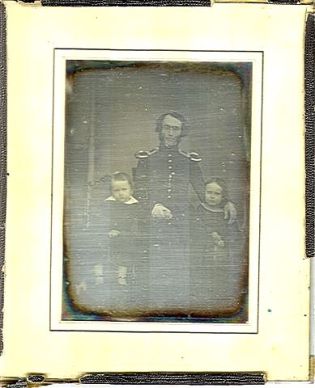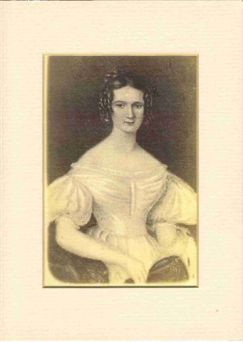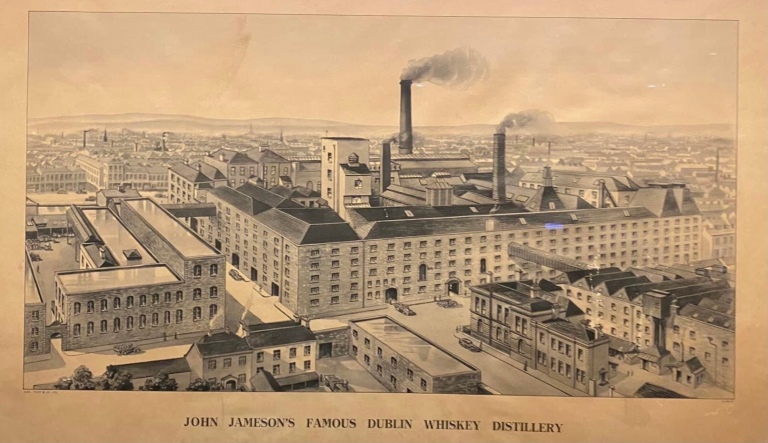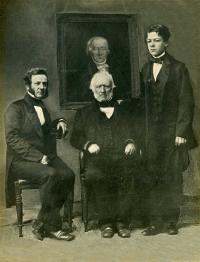The Jameson Connection
by
Hamish J. Thoms
I have always been somewhat curious about the given, middle names in my family. Grahame Thom, the clan MacThomas Sennachie, very recently published an article on the Clan MacThomas website entitled the Hunter Connection and it links the numerous family members who inherited the Hunter name as far back as 1737. The last member of my immediate family to be given the Hunter name, was my brother, Charles Robert Hunter Thoms. Our father, Bernard Hunter Jameson Thoms was fortunate enough to have been given both Hunter and Jameson as middle names, and the Jameson middle name was eventually passed down to me and Bernard’s great grandson, Logan George Jameson Russell. I have always been interested in the derivation of this name and the ancestors who carried the Jameson legacy down through the generations. However, only recently have I discovered some of my early Jameson kinfolk, and while research is ongoing I have been able to trace some ancestors back to the end of the 17th Century.
 Dr.James Duncan with Andrew and Rachel Duncan
Dr.James Duncan with Andrew and Rachel Duncan
My great grandmother’s name was Rachel Jameson Duncan, who became the wife of Thomas Watt Thoms, youngest son of Patrick Hunter Thoms, 15th Chief of Clan MacThomas. Rachel was orphaned at the age of seven, along with her younger siblings, Andrew and Hanna Duncan, after their father died en route from India to Dundee in 1848. Major James Duncan had been employed as a medical officer by the East India Company and had been stationed in Chittagong. His wife, Rachel Ogilvie had died previously on 21 September 1846 at Cherrapunje, Meghalaya, India, at the age of 30.
 Rachel Ogilvie
Rachel Ogilvie
The following tragic story, entitled “A Leal Trust”, was related and eventually written down by my aunt, Brenda Beament, only daughter of Henry James Macthomas Thoms.
“In the fourth decade of the nineteenth century Dr. James Duncan and his young wife Rachel Ogilvie sailed for India from Dundee, Scotland. They settled in Chittagong where the doctor practiced for the East India Company for some years with skill and devotion. Rachel died at the birth of their third baby.
Broken hearted and himself a victim of fever the bereaved doctor decided he must take the children back to Scotland. With the support and help of an Ayah he packed up and all set sail from Calcutta for the long journey home. Shortly before the ship reached Capetown the doctor died. On his deathbed he asked the Ayah to promise to deliver the three little children into the hands of their grandfather in Dundee. At Capetown the Authorities made every attempt to take over responsibility for the care and ongoing journey of the children and send the Indian woman home. However she remained adamant and said she had given her word of honour to take them to Scotland. She won her point and after a long voyage delivered the little ones to their austere but kindly grandfather, James Ogilvie. Time passed and ever the devoted nurse looked after her charges. It was then a most unusual sight to see a Asiatic in an East of Scotland town and a native woman in her sari, wheeling a pram with a toddler on either side, provoked much stir.
One day it came to the grandfather’s notice that some cruel and thoughtless people had shouted and abused the Ayah; “ugly black pagan” they had cried, “awa to your haeme”. He was deeply troubled and angered. Knowing he was well on in years he had made provision for the children’s future but realized without his protection the future for the simple Indian woman was very hazardous. He journeyed to Edinburgh to put his problem to the Church of Scotland Missionary Society and plans were made that when a missionary and his wife were going to the neighbourhood of Chittagong they would escort the Ayah back to her home, even he begged, to her very village. The grandfather returned home greatly relieved, with his conscience more at rest.
Eventually a young minister accompanied by his wife came to call on lawyer Ogilvie saying they were shortly sailing for Calcutta and proceeding to Chittagong and would gladly take the Ayah with them. Arrangements were made and the day of parting came. Quietly and with dignity the Ayah kissed the children goodbye and followed the minister on board ship. As they sailed down the River Tay she asked leave to stand in the stern to watch the darkening shore recede as the river gave place to the sea. Only one of the sailors heard a wailing cry “I canno leave my bairns” and saw her plunge into the water.”
 Rachel Jameson Duncan
Rachel Jameson Duncan
Rachel and her siblings were taken in and raised by their maternal grandfather, James Ogilvie and his wife, Rachel Jameson. James Ogilvie was an established and succesful lawyer in Dundee. He was born on 2 November 1780 in Dundee, Forfar (Angus), Scotland. He was christened and named after his paternal grandfather, James Ogilvie, on 14 November 1780. He was a partner in J Ogilvie & Son, Solicitors in Dundee, founded by his father, John, which became known as John and James Ogilvie, or J & J Ogilvie. James was a member of the Town Council, and held the office of Assessor to the Dean for one year. He married Rachel Jameson, daughter of John Jameson and Sophia Anderson on 8 January 1805. James Ogilvie died on 2 June 1867 at 1 Park Place, Dundee, Forfar, Scotland, at age 86; At the time of his death, he was the oldest solicitor in Dundee. He and Rachel Jameson had eight children:
Susanna Ogilvie b. 12 Jun 1807
John Ogilvie b. 17 Jul 1810, d. 9 Sep 1869
James Ogilvie b. 1811, d. 29 Nov 1836
Andrew Jameson Ogilvie b. 27 Jun 1814, d. 31 Aug 1898
Rachel Ogilvie b. 2 Aug 1816, d. 21 Sep 1846
George Ogilvie b. 12 Jul 1818, d. Jul 1850
Duncan Ogilvie b. 28 Apr 1820, d. 20 Jun 1842
William Ogilvie b. 8 Jan 1823
Harriet Ogilvie b. 13 Apr 1825
James Ogilvie
Rachel Jameson, born on 6 March 1780 at Dysart, was the youngest daughter of John Jameson. She married James Ogilvie, son of John Ogilvie and Susan Duncan, on 8 January 1805. Rachel Jameson died in February 1857 at age 76. She was buried on 19 February 1857 at Old Howff Cemetery in Dundee, Scotland.
John Jameson was born in 1741. He was educated in 1755 at St Andrews University and was sent to Edinburgh to complete his education where he studied civil law with his father’s friend, a Mr. Orme. He was a lawyer and was appointed Town Clerk for the town of Dysart. He was also a factor for a local landowner, Col. St Clair. He married Sophia Anderson about 1770. Sophia was the widow of John Anderson and had several children by him. John Jameson died in 1819 of a bowel complaint. In addition to his youngest daughter, Rachel Jameson, John and his wife had three other children:
Andrew Jameson b. 1771, d. 1846
Rachel’s older brother, Andrew Jameson, was born in 1771 at Dysart. He was educated at St Andrews. He married Euphemia Chalmers in October 1802 and they had eight children:
John St Clair Jameson b. 12 Aug 1803, d. 1820
James Jameson b. 14 Mar 1805, d. 15 Jan 1832
Elizabeth (Betsy) Robertson Jameson b. 20 Jun 1806, d. 1823
Sophia Margaret Jameson b. 17 Mar 1808, d. 1894
Robert Thomson Jameson b. 20 Jul 1809, d. 11 Aug 1832
Andrew Jameson b. 30 Apr 1811, d. 30 Oct 1870
Melville Jameson b. 11 May 1813
Euphemia Jameson b. 1815, d. 1822
Captain James Jameson b. 27 Apr 1773, d. 1834.
Rachel’s other brother, Captain James Jameson, was born on 27 April 1773 at Dysart. He was educated at Perth Academy. He married Elizabeth Robertson circa 1805. James had a distinguished career in the East India Company Merchant Marine. In 1831 he went to Calcutta where he was Master Attendant, the most senior post abroad of the E.I. Company Maritime. He bought “Drums” from Robert Thomson (no relation). “Drums” was a large house near Freuchie in the parish of Falkland, overlooking the valley of the River Eden. His brother, Andrew, acted as factor when James was away in India. Captain James and his wife, Elizabeth, had no children. He died in 1834.
Sophia Jameson b. 17 May 1774, d. a 1836
Rachel’s older sister, Sophia Jameson, was born on 17 May 1774 at Dysart. She married James Thomson circa 1806. They lived at Eden Park, near Cupar, and had five children.
The most distinguished offspring of Andrew Jameson (1771-1846), Rachel Jameson’s brother, was his son, Andrew Jameson (1811-1870).

Sheriff Andrew Jameson
Andrew Jameson was born on 30 April 1811 at Cupar, Fife. He was educated at Perth Grammar School and St Andrews University and then studied law at Edinburgh University. He was called to the Bar in 1835 and in 1843 was appointed Sheriff-Substitute of Ayrshire and Midlothian. He was transferred to Edinburgh and appointed Sheriff* of Aberdeen on 6 November 1865. In 1854 Sheriff Jameson drew up a constitution – civil and criminal code – for the Island of Malta, and was distinguished for his sound judgments and consciencious diligence in rendering opinions. He took a great interest in the Protestant Churches on the Continent and, being an accomplished scholar in Italian, French and Spanish, he was able to support newly founded Churches in Italy and Spain by visiting them and raising funds for their assistance. Sheriff Jameson was an elder of the Free Church in Edinburgh and legal adviser to their ministry. He first married Alexandra (Alexa) Grace Campbell in 1844. After her death in 1848, Sheriff Andrew Jameson married Margaret Hart Hotchkis, daughter of James Hotchkis and Margaret Hart, on 28 July 1853. Sheriff Andrew Jameson lived in 1860 at Brentfield Terrace, Edinburgh. He died on 30 October 1870 at age 59 of diphtheria within a few days of visiting his son, John, who became ill and died from the disease.
Married (1)
Alexandra (Alexa) Grace Campbell d. Dec 1848
Children:
Andrew Jameson b. 1845, d. 1911
Alexander Jameson b. c 1846, d. c 1851
John St Clair Jameson b. 1848, d. Oct 1870
Married (2)
Margaret Hart Hotchkis b. 1830, d. 1897
Child:
James Hotchkis Jameson b. 1855, d. 1937
From his marriage to Alexandra Grace Campbell, Sheriff Andrew Jameson’s first son, Andrew Jameson went on to become Lord Ardwell by changing his name by deed poll to McCulloch in order to inherit his wife’s estate. Born at Ayr on 5 July 1845, he was the eldest son of Andrew Jameson, sheriff of Aberdeen and Kincardine. Educated at Edinburgh Academy, he graduated M.A. from the University of St Andrews in 1865. He afterwards attended Edinburgh University, and on 19 May 1870 he passed at the Scottish bar, where he gradually built up a practice. In 1882 Jameson was appointed junior counsel to the Department of Woods and Forests.

Andrew Jameson, Lord Ardwell
On 27 April 1886 Andrew Jameson was made Sheriff of Roxburghshire, Berwickshire, and Selkirkshire. Having taken part in politics as a Liberal Unionist, he received from Lord Salisbury’s government the office of sheriff of the counties of Ross and Cromarty, and Sutherland on 28 November 1890, and became sheriff of Perthshire on 27 October 1891. On the resignation of Henry Moncreiff, 2nd Baron Moncreiff, Jameson was raised to the bench on 6 January 1905, with the title of Lord Ardwall. In the same year he was made honorary LL.D. of St. Andrews. After an illness of about six months he died on November 21, 1911, at 14 Moray Place, Edinburgh,, and was buried at Anwoth in Kirkcudbrightshire.
John Jameson, Rachel Jameson’s father, was the son of Andrew Jameson and Margaret Gib. Andrew Jameson was born in 1708 at Dollar, Clackmannan. As a child he studied the classics. Andrew was admitted as a Notary Public in 1733. He studied law under Alexander Orme, a Writer to the Signet** and practiced law in the small Fife town of Strathmiglo, and later in Leven. He married Margaret Gib on 20 August 1735 at Couland. In 1738 he purchased Craighall in the parish of Cupar. His parents came to live with him in 1740.

Baptismal record of Andrew, son to William Jameson, Oct 3, 1708.
After his first wife died in 1744, Andrew Jameson married Betty Kay in 1745 at Old Greyfriars Church, Edinburgh. Andrew played a small role during the Jacobite rebellion in 1745 as a loyal supporter of King George II. He had acquired property through his wives (he married a third time to Rachel Wilson) and inherited property from his father, William Jameson. In 1773 he had to convey all his property to an accountant in Edinburgh, John Hay, trustee for his creditors. He went to live with his daughter, Jean, at Barnhill, near Saline, a village between Clackmannan and Kelty. Andrew Jameson died in 1782 and was buried in Dollar churchyard in the parish where he was born. With his first wife, Margaret Gib, he had four children:
Jean Jameson b. 1738, d. 1831
Jean Jameson was born in 1738 at Craighall. Jean Jameson lived to be 93 and provided much of the 18th century family history for her grand-nephew, Sheriff Andrew’s memoirs. When her brother, James Jameson, died in India he left a considerable fortune which allowed his unmarried sister to purchase Graycraig and live in a manner that allowed her to be designated “Miss Jameson of Graycraig”. She died in 1831 and was buried at Saline churchyard. In her will Jean bequeathed the property and £6,000 to the Rev A.B. Duncan, minister at Culross.
Janet Jameson b. 1740, d. 1777
Janet Jameson was born in 1740. She married Rev Neil Bethune in 1759. Janet Jameson died in 1777.
John Jameson b. 1741, d. 1819
Rachel Jameson’s father.
James Jameson b. 1743
Died in India, and left a considerable fortune to his sister, Jean Jameson.
The father of Andrew Jameson (1708-1782) was William Jameson, a tenant farmer near Dollarberg. According to the “Outline of Family History” penned by Andrew Jameson (1811-1870), William Jameson was born around 1680, and is described as a portioner of Middletown of Wester Luscar in the parish of Carnock. On October 19, 1707, William married Jean Burn, the widow of the laird of Dollarberg, whose surname was Scotland. When the laird died about 1705, he left his wife quite well off since under her husband’s will, Jean inherited the life-rent of some property at Dollarberg. She already had the life-rent of another property at Wester Luscar but how she had obtained this asset is unclear. Given Jean’s circumstances, William Jameson probably found this an attractive match. The marriage of William and Jean Burn in 1707 produced a son, Andrew, born on October 3, 1708.
From her former marriage to the laird of Dollarberg, Jean had produced several children. Her eldest daughter married William’s brother, whose name is unknown. Her eldest son, Thomas Scotland, lived with William and Jean at her home in Dollarberg, until he came of age and then inherited the property. At that time the Jameson’s moved to Wester Luscar, and in 1722, William was able to purchase a third part of the property. In 1740, the Jameson’s sold their lands of Wester Lucar and went to live with their son, Andrew, at Craighall, near Ceres, where Jean Jameson died in 1744. Her husband, William lived on for several years until his death, circa 1746/47.
As a postscript to this information, it is interesting to note that Andrew James Duncan, the orphaned brother of Rachel Jameson Duncan would go on to be a doctor, like his father, and would eventually marry Emily Henrietta Walker on 27th September 1876. Emily was the youngest of the four children of Crawford Walker, a Dundee merchant, and his wife Isabella Thoms. This Isabella Thoms was youngest daughter of Baillie George Thomas or Thoms, and thus sister to Provost Patrick Hunter Thoms, 1st Laird of Aberlemno, who was some fifteen years her senior. Emily Henrietta Walker lost her mother when she was just over one year old, and her father a little over two years later, when she was almost three and-a-half, so that she can hardly have had any recollection of her parents in later life. She was brought up from infancy in the home of Provost Thoms, her uncle, and thus lived as one of his own family until her marriage at the age of 27 to Dr. Andrew James Duncan.
Of Further Interest
There was another Jameson family who resided very close to the town of Dollar in Clackmannanshire and it would not surprise me if the two families were somehow related. John Jameson was the founder of the Jameson Irish Whiskey Company.

John Jameson
The company was established in 1780 when John Jameson established the Bow Street Distillery in Dublin. Jameson was born in Alloa, Clackmannanshire, sometime before 1740. He was a lawyer from Alloa who had married Margaret Haig, a sister of the brothers who founded the main Haig Scotch whisky firms, and related to the Steins, a Scottish distilling family with interests in Dublin. Originally one of the six main Dublin Whiskeys, Jameson is now distilled in Cork.

Jameson is by far the best selling Irish whiskey in the world, as it has been sold internationally since the early 19th century when John Jameson along with his son (also named John) was producing more than a million gallons annually. John Jameson died on 3 December, 1823 in Alloa. The town of Dollar is exactly 11 kilometers from the town of Alloa.
Note * A sheriff in Scotland differs considerably from its counterpart in the United States and Canada. Scotland’s sheriffs deal with the vast majority of civil and criminal cases at first instance. Sheriffs principal are mostly Queen’s Counsel and sheriffs are either advocates or solicitors though many are also Queen’s Counsel. All will have had considerable court experience. Each Sheriffdom has a sheriff principal charged with a number of duties in respect of the courts for which they are responsible, including in particular a duty “to secure the efficient disposal of business in the sheriff courts of that Sheriffdom”. Criminal cases are heard by a sheriff and a jury (solemn procedure), but can be heard by a sheriff alone (summary procedure). Civil matters are also heard by a sheriff sitting alone.
At present, there are six Sheriffdoms in Scotland each with its own sheriff principal.
Glasgow and Strathkelvin
Grampian, Highland and Islands;
Lothian and Borders;
North Strathclyde;
South Strathclyde, Dumfries and Galloway;
Tayside, Central and Fife
Note ** Writer to the Signet. In Scottish law, an officer closely corresponding to an attorney at law in English and American practice. “Writers to the signet,” also called “clerks to the signet” derive their name from the circumstance that they were anciently clerks in the office of the secretary of state, by whom writs were prepared and issued under the royal signet or seal; and, when the signet became employed in judicial proceedings, they obtained a monopoly of the privileges of acting as agents or attorneys before the court of session. – Black’s Law Dictionary
Sources:
Brenda Beament, “A Leal Trust”, Unpublished Letter.
I am indebted to Rachel Godfrey, who has supplied much information on the Ogilvie and Jameson families, and granted permission to use some of the photographs used in the article above and found on http://ogilviefamilytree.com/index.htm
I am also indebted to my cousin Brian Turnbull for originally providing images of family members.
Scotland, Births and Baptisms, 1564-1950,” index, FamilySearch
https://www.geni.com/people/John-Jameson/6000000013102324034
http://www.scotland-judiciary.org.uk/35/0/Sheriffs-Principal
https://www.scotlandspeople.gov.uk/user/370985
https://en.wikipedia.org/wiki/Andrew_Jameson,_Lord_Ardwall
For a detailed account of Sheriff Andrew Jameson see Andrew Jameson: A Prophet Without Honour, by D.H.F. Gourlay in The Law Journal of the Scottish Universities, Part 1, 2011
Also by Dr. Gourlay, see Sheriff Andrew Jameson: The Life of Effie Gray’s Uncle, (pub. 2015 by Melrose Books.)
